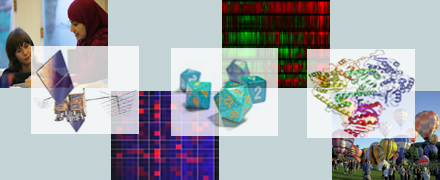|
SuSTaIn
Events
Astrostatistics
Overview
Invited speakers
Programme
Posters
Registration
Financial Assistance
Venue
Enquiries
Contact
send an email
|
|
SuSTaIn EdgeCutter One Day Workshop on
"Astrostatistics"
Royal Statistical Society, London, UK
17th December 2014
ABSTRACTS
Measuring Galaxy Shapes from Noisy, Blurry Images.
I will describe the great potential and possible limitations of using the
bending of light by gravity (gravitational lensing) to constrain the
mysterious dark energy which seems to dominate the contents of our Universe.
In particular we have to remove the blurring effects of our telescopes
and the atmosphere to extreme precision, to measure the shapes of galaxies
to extreme accuracy. I will discuss the recent GREAT image analysis
Challenges we have set to astronomers and beyond and review some recent
progress in tackling the problem. In particular I will focus on the upcoming
Dark Energy Survey which will measure approximate distances and shapes of
300 million galaxies over one eighth of the sky.
Measuring the Length of the Cosmological Ruler
The Baryon Acoustic Oscillation feature is a key observable in cosmology,
corresponding to the maximum distance sound waves can travel in the Universe.
It leaves a measurable imprint in the clustering of galaxies at late times.
Normally cosmological models are fitted to BAO data along with everything
else, but it turns out to be possible to measure it in a way that is
completely independent of the cosmological model.
With very weak assumptions of symmetry and a smooth expansion history
(not even assuming General Relativity), the length of the BAO scale is
measured using MCMC techniques to be 103.9+/-2.3 Mpc/h, a length that any
theoretical model must account for to be viable.
Since the length is set early on in the Universe's history,
the conclusions are independent of late-time physics such as Dark Energy
properties or late modifications to gravity. Even without GR,
we find that the Universe looks very much like the standard LCDM model,
for which the scale is 99.3+/-2.1 Mpc/h.
Sparsity in Astrophysics: Astrostatistics meets Astroinformatics
Astrostatistics has become a well-established sub-field,
where powerful statistical methods are developed and applied to extract
scientific information from astrophysical observations.
Astroinformatics, on the other hand, is an evolving but less mature sub-field,
where informatics techniques provide a powerful alternative approach for
extracting scientific information from observational data.
Informatics techniques have close links with information theory,
signal processing and computational harmonic analysis,
and have been demonstrated to be very effective.
Wavelet methods, for example, allow one to probe both spatial- and
scale-dependent signal characteristics simultaneously.
Such techniques are very effective in studying physical phenomena since
many physical processes are manifest on particular physical scales,
while also spatially localised.
Recent developments in this domain have led to the theory of
compressive sensing, a revolutionary breakthrough in the field of sampling
theory, which exploits the sparsity of natural signals.
I will introduce compressive sensing from both the synthesis and analysis
perspectives, highlighting statistical connections, and discuss the
application of such techniques to radio interferometric imaging.
Principled Corner Cutting in Astrostatistics: Valid Statistical
Comparisons Without Valid MCMC Output
Modern statistical data analysis is complex. The competing demands of
massive data streams and sophisticated science-driven models require us to
make compromises—sometimes unconsciously—between methodological rigor and
practical constraints like time, energy, funding, expertise,
access to information, etc. Astrostatistics is certainly not immune to
such corner cutting. Having to prematurely terminate an MCMC
(Markov chain Monte Carlo) sampler is a familiar example,
all the more so when a suite of samplers are deployed to simulate the
null distribution of a test statistic. This does not necessarily imply,
however, that the resulting statistical inference is invalid.
In the context of hypothesis testing and model selection,
it is entirely possible to use the output of premature MCMC samplers
to form p-values that are valid in that they exhibit the desired Type-I error.
The cost of this faster computation is the potential loss of statistical power.
Using the example of detecting X-ray jets associated with quasars,
we demonstrate that this trade-off may be worthwhile;
a 65% increase in computational power, for example, may be traded for a
15% reduction in statistical power. We provide a theoretical framework for
investigating such Monte Carlo tests by formulating them as a new class of
randomized tests. This is a new use of randomization tests which were
proposed to achieve theoretically exact Type-I errors,
not to navigate the practical trade-offs between statistical and
computational efficiency.
(This is joint work with Nathan Stein and David van Dyk.)
Bayesian Model Comparison in Astronomy and Cosmology.
Bayesian inference provides a self-consistent method of model comparison,
provided that i) there are at least two models under consideration and
ii) all the models in question have fully-specified and proper parameter priors.
Unfortunately, these requirements are not always satisfied in astronomy
and cosmology: despite the existence of exquisitely-characterised
measurements and quantitative physical models (i.e., sufficient to compute
a believable likelihood), these models generally have parameters without
well-motivated priors, making completely rigorous model comparison a formal
impossibility. Still, huge advances have been made in cosmology,
in particular, in the last few decades, implying that model comparison
(and testing) is possible in practice even without fully specified priors.
I will discuss the above principles and then illustrate some test cases of
varying rigour, outlining some schemes for formalising heuristic approaches
to model testing within a Bayesian framework.
Inverse Problems in Astrophysics
We present the concept of sparse representations, and we show how sparsity
helps us to regularize several inverse problems that occurs in different
astronomical projects such as Corot, PLANCK or Euclid.
Several applications will be addressed: the case of missing data,
the component separation problem from one image or from multichannel data,
and finally the 3D weak lensing tomographic density map reconstruction.
Beyond Precision Cosmology
The avalanche of data over the past 10-20 years has propelled cosmology
into the “precision era”. The next challenge cosmology has to meet is to
enter the era of accuracy. Because of the intrinsic nature of studying the
Cosmos and the sheer amount of data available and coming,
the only way to meet these challenges is by developing suitable and
specific statistical techniques.
The road from precision Cosmology to accurate Cosmology goes through
statistical Cosmology. I will outline some open challenges and discuss some
specific examples.
Bayesian Emulation and History Matching for the Uncertainty Analysis of a Galaxy Formation Simulation
Cosmologists test their knowledge of the evolution of structure formation
by developing models of galaxy formation.
Many models are now so complex that analysing their behaviour,
comparing them to observed data and performing a full uncertainty analysis
all represent extremely challenging tasks.
Major difficulties include the significant run time required for one model
evaluation and dealing with the large numbers of input parameters that must
be specified for the model to run.
This project deals with a complex model of the Universe known as Galform,
developed by the ICC group, at Durham University.
This model simulates the creation and evolution of millions of galaxies
from the beginning of the Universe until the current day,
a process which is very sensitive to current theories of cosmology and
structure formation. The outputs of Galform can be compared to available
observational data,
and the general goal of the project is to identify which input parameter
specifications will give rise to acceptable matches between model output
and observed data, given the many types of uncertainty present in such
a situation. As the model takes significant time to run,
and the input parameter space is large, this is a very difficult task.
We have solved this problem using general techniques related to the
Bayesian treatment of uncertainty for computer models.
These techniques are centred around the use of emulators:
stochastic approximations to the full Galform model that mimic the
behaviour of Galform with differing and controllable levels of accuracy
over the input space, and which are several orders of magnitude faster to
evaluate. Emulators allow detailed analysis of the structure of the model,
global parameter space searching techniques (known as history matching),
and efficient visualisation of results. They fit naturally within a
comprehensive Bayesian uncertainty analysis,
and are applicable to an extremely wide class of complex models,
across a range of scientific disciplines.
Back to Programme page
Back to main Astrostatistics Workshop page
|





